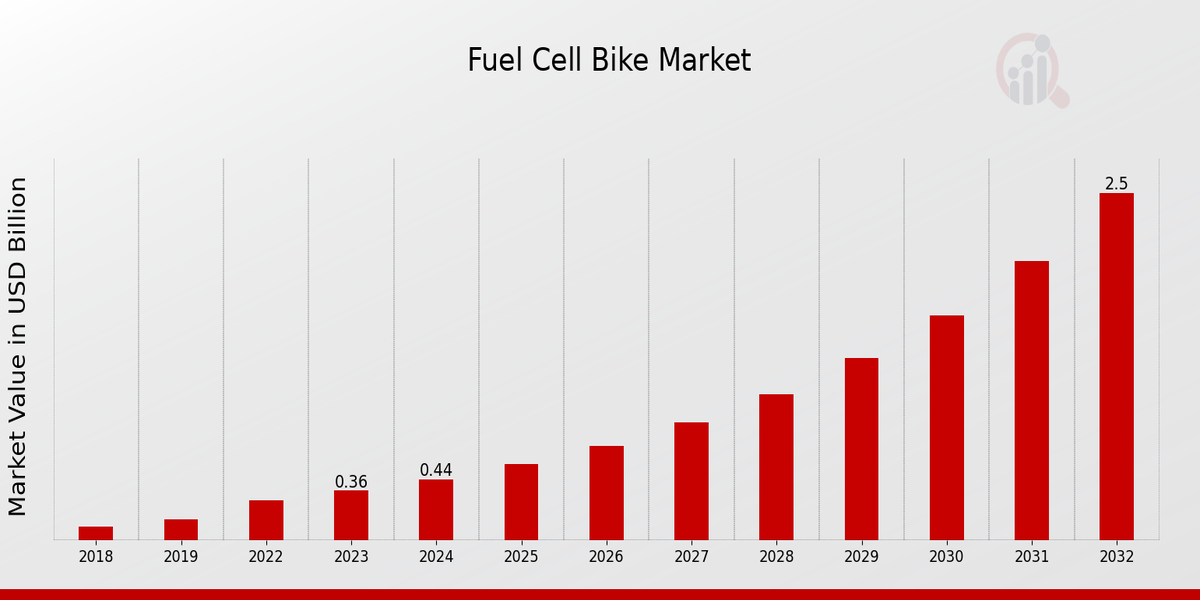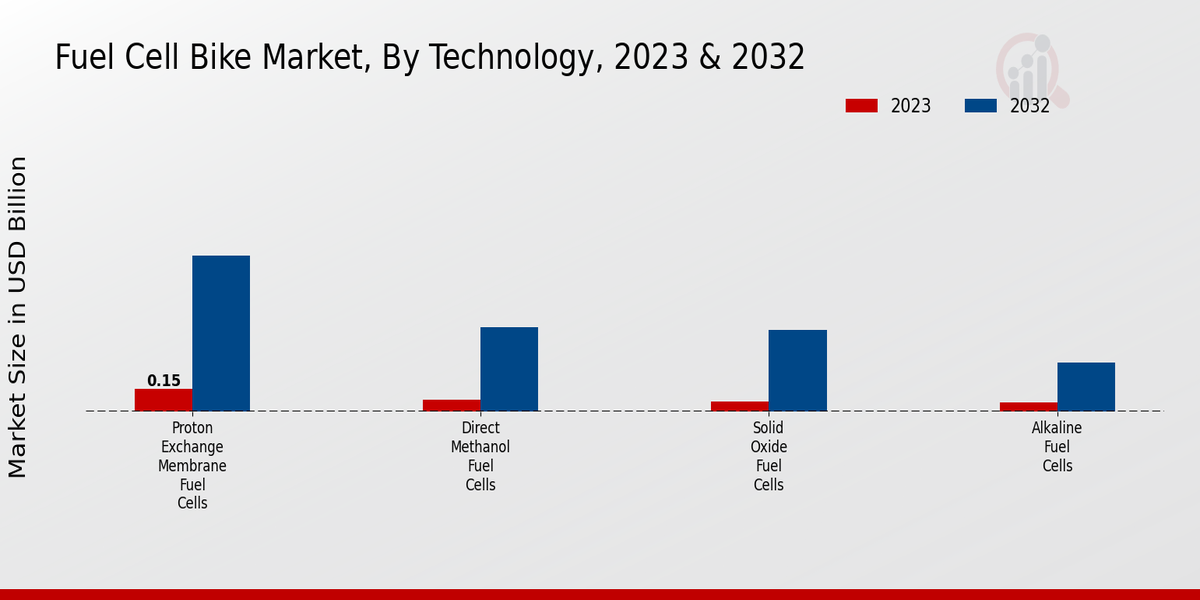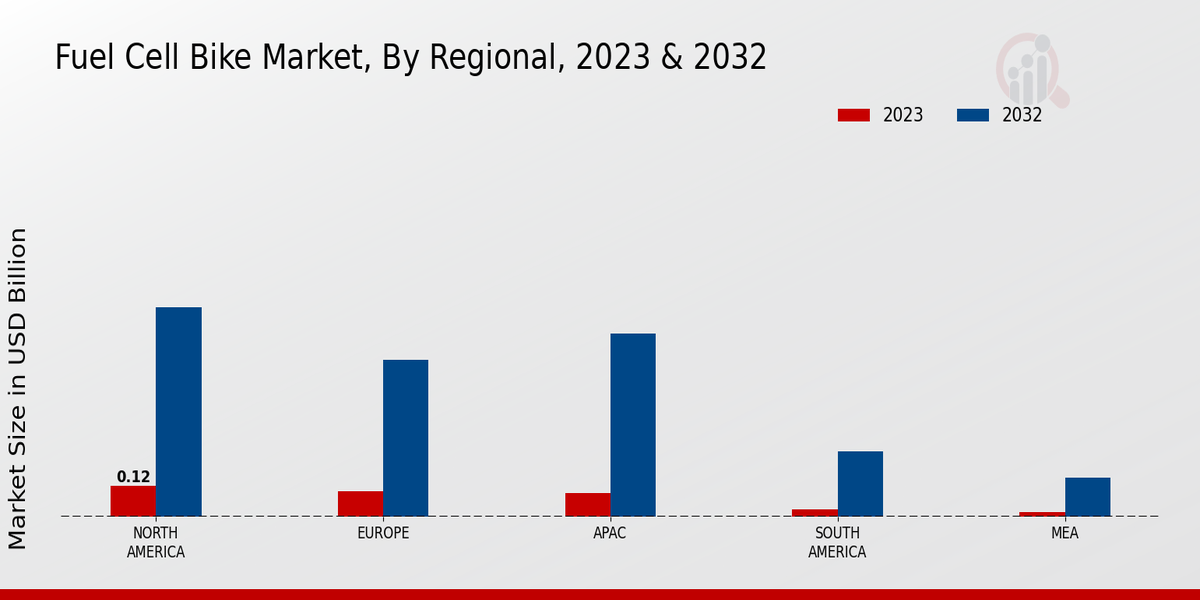Fuel Cell Bike Market Overview:
As per MRFR analysis, the Fuel Cell Bike Market Size was estimated at 0.29 (USD Billion) in 2022. The Fuel Cell Bike Market Industry is expected to grow from 0.36(USD Billion) in 2023 to 2.5 (USD Billion) by 2032. The Fuel Cell Bike Market CAGR (growth rate) is expected to be around 24.16% during the forecast period (2024 - 2032).
Key Fuel Cell Bike Market Trends Highlighted
The Fuel Cell Bike Market is experiencing significant growth triggered by various key market drivers. Increasing environmental awareness and the need for sustainable transportation options are pushing consumers and manufacturers to explore cleaner alternatives to traditional fossil fuel-powered vehicles. Moreover, advancements in fuel cell technology are enhancing the performance and efficiency of electric bikes, making them more appealing to a broader audience. The growing infrastructure to support hydrogen fuel stations is further fueling the adoption of fuel cell bikes. Government incentives and policies promoting green energy are also playing a crucial role in boosting market development.The market presents numerous opportunities to be explored, especially in regions looking to reduce air pollution and dependence on oil. Urban areas can benefit from the introduction of fuel-cell bikes as a means to mitigate traffic congestion while promoting eco-friendly transportation. Furthermore, collaboration between manufacturers and technology providers can lead to innovative solutions that enhance bike performance. There is a chance for niche markets to develop customizable fuel cell bikes catering to specific consumer needs, such as cargo transport or recreational use. Companies that focus on research and development can also capture market share by introducing next-generation fuel cell systems that offer greater range and shorter refueling times.Recently, trends in the market indicate a shift towards integrating smart technology in fuel cell bikes. This includes features like GPS navigation, advanced safety systems, and connectivity with mobile devices. Additionally, the rise of subscription-based service models is gaining popularity, enabling users to access bikes without the need for ownership. The design of fuel cell bikes is also evolving, with a focus on aesthetics and user comfort. As manufacturers strive to make fuel cell bikes more attractive and convenient, the market is expected to keep evolving, appealing to environmentally conscious consumers and urban commuters alike.

Source: Primary Research, Secondary Research, MRFR Database and Analyst Review
Fuel Cell Bike Market Drivers
Growing Environmental Awareness and Demand for Clean Transportation
The Fuel Cell Bike Market Industry is significantly driven by the increasing awareness of environmental issues and the demand for cleaner transportation options. As urbanization continues and population densities rise, cities around the world are grappling with pollution and traffic congestion. Traditional vehicles are major contributors to air pollution, leading to health problems and environmental degradation. As a result, consumers are actively seeking alternative modes of transport that align with sustainable living practices.Fuel cell bikes, characterized by their zero-emission energy systems, present an attractive solution to this growing concern. These bikes utilize hydrogen fuel cells, which convert hydrogen directly into electricity, emitting only water vapor as a byproduct. This aligns perfectly with efforts to reduce carbon footprints and combat climate change. Furthermore, governments and various organizations are promoting initiatives to support the use of green technologies, ensuring that riders of fuel cell bikes are not only contributing to a cleaner environment but are also part of the larger movement towards sustainable urban mobility.The significant market growth forecasted in the upcoming years reflects an increasing trend among consumers to shift their preferences towards environmentally friendly transportation alternatives as they become more conscientious of their impact on the planet.
Technological Advancements in Fuel Cell Technology
Technological advancements in fuel cell technology are key drivers for the Fuel Cell Bike Market Industry. Innovations are leading to improvements in fuel cell efficiency, reducing weight and enhancing the overall performance of fuel cell bikes. Manufacturers are continuously investing in research and development to integrate lighter materials and more efficient fuel cells, making these bikes more accessible and attractive to consumers. Additionally, the development of infrastructure for hydrogen fuel production and distribution is advancing rapidly, facilitating the adoption of fuel cell bikes in urban environments.As these technologies continue to evolve, they will play a critical role in enhancing the viability of fuel-cell bikes as a mainstream transportation option.
Government Incentives and Support for Green Transportation
Government incentives and support for green transportation significantly influence the Fuel Cell Bike Market Industry. Many countries are implementing policies to encourage the adoption of environmentally friendly transportation solutions. These initiatives may include financial incentives, tax credits, grants and support for infrastructure development that facilitates hydrogen production and distribution. By making fuel cell bikes economically attractive, governments are helping to promote their use, further driving market growth.As these incentives expand, they enhance consumer confidence and encourage more individuals to consider fuel-cell bikes as a viable transportation alternative, leading to increased market penetration.
Fuel Cell Bike Market Segment Insights:
Fuel Cell Bike Market Technology Insights
The Fuel Cell Bike Market, particularly within the Technology segment, showcases substantial growth, supported by various fuel cell technologies aimed at enhancing energy efficiency and reducing emissions. In 2023, the market highlighted a valuation of 0.36 USD Billion, demonstrating a foundational level of investment and interest in eco-friendly transportation solutions. The Proton Exchange Membrane Fuel Cells (PEMFC) are remarkable within this market framework, holding a valuation of 0.15 USD Billion in 2023, with projections reaching 1.05 USD Billion by 2032, indicating a majority holding position in driving innovation and implementation due to their high efficiency and low-temperature operation.
The Direct Methanol Fuel Cells (DMFC) also present significant potential, valued at 0.08 USD Billion in 2023, rising to an estimated 0.57 USD Billion in 2032. The applicability of DMFC in smaller devices, coupled with easy fuel storage, positions it as an attractive option for users seeking both convenience and efficiency. Though comparatively smaller, the Solid Oxide Fuel Cells (SOFC), valued at 0.07 USD Billion in 2023, with a future valuation of 0.55 USD Billion, indicate a growing interest, with their high efficiency at larger scales potentially revolutionizing the longer-range capabilities of fuel cell bikes. The Alkaline Fuel Cells (AFC) segment, while valued at 0.06 USD Billion in 2023, expects to reach 0.33 USD Billion by 2032, demonstrating a steady presence in the market, characterized by cost-effectiveness and broad applications.
In summary, the Fuel Cell Bike Market reflects a dynamic environment with Technology playing a critical role, as various fuel cell types undergo advancements to cater to diverse consumer needs and preferences. The primary driving forces behind this burgeoning market include technological innovations, regulatory support to reduce carbon emissions, and a growing demand for green transport solutions. This synthesis of market growth trends and segment valuation provides a clear picture of an evolving landscape where the quest for sustainable mobility methods continues to gain momentum. The interplay of these fuel cell technologies represents both challenges and opportunities as market players aim to navigate advancements that will bolster their presence within the larger Fuel Cell Bike Market industry.

Source: Primary Research, Secondary Research, MRFR Database and Analyst Review
Fuel Cell Bike Market Type Insights
The market segmentation encompasses various types, including bicycles, motorcycles, and scooters, each playing a critical role in driving the industry's expansion. The bicycle segment captures attention for its sustainability features and eco-friendly appeal, making it a preferred option among urban commuters. Motorcycles represent another integral part of this market, attracting consumers with their efficiency and performance benefits.Scooters, on the other hand, are favored for their compactness and convenience in navigating congested urban areas. The combined demand for these types is contributing significantly to the anticipated revenue growth dynamics of the Fuel Cell Bike Market, which is projected to reach an impressive 2.5 USD Billion by 2032.
Fuel Cell Bike Market Application Insights
This surge is driven by increasing environmental concerns and the push for sustainable transportation solutions. Within this segment, Urban Commuting is emerging as a critical application, appealing to city dwellers seeking eco-friendly alternatives to traditional bikes. Recreational Riding is gaining traction as recreational activities become increasingly popular, with fuel-cell bikes providing a clean and efficient option for leisurely rides.Delivery Services are also becoming vital within the market as businesses look for efficient, zero-emission transportation solutions for goods delivery. The growing emphasis on tourism is enhancing the demand for fuel-cell bikes, providing tourists with a sustainable and enjoyable way to explore new destinations. These applications represent the diverse potential of the Fuel Cell Bike Market, creating opportunities while addressing challenges such as infrastructure investment and consumer awareness. Driven by the benefits of reduced emissions and innovative technologies, the market continues to evolve, enhancing its contribution to the Fuel Cell Bike Market statistics and data landscape.
Fuel Cell Bike Market End Use Insights
The Fuel Cell Bike Market is experiencing substantial growth driven by varied end-use applications. The End Use segment is primarily classified into Personal, Commercial and Government applications, with the personal segment experiencing significant adoption due to increased environmental awareness and the demand for eco-friendly commuting solutions. The commercial sector plays a crucial role by integrating fuel cell bikes into delivery and logistics services, which contribute to reducing carbon footprints while maintaining efficiency.Furthermore, government initiatives supporting clean energy transportation are enhancing the adoption of fuel cell bikes, as various programs promote sustainability in the public and private sectors. These factors combined present a compelling case for growth within the Fuel Cell Bike Market, emphasizing the significant contributions of each end-use category in improving urban mobility and reducing greenhouse gas emissions. Overall, the Fuel Cell Bike Market authorities are witnessing a shifting trend toward cleaner and more efficient transportation solutions, which is spawning an array of opportunities across different economic sectors.
Fuel Cell Bike Market Regional Insights
The Fuel Cell Bike Market is witnessing substantial growth across various regions, with notable performances in North America and Europe, where these markets are valued at 0.12 USD Billion and 0.1 USD Billion, respectively, in 2023. North America dominates with its significant investment in clean energy and advanced technologies, projected to reach 0.8 USD Billion by 2032. Europe follows closely with a market valuation of 0.6 USD Billion in the same year, driven by strong governmental support for sustainable transport solutions. APAC holds an essential position with a valuation of 0.09 USD Billion in 2023, which is expected to grow to 0.7 USD Billion by 2032, led by increasing urbanization and rising energy demands.South America and MEA are relatively smaller markets, valued at 0.03 USD Billion and 0.02 USD Billion, respectively, in 2023, but are expected to expand to 0.25 USD Billion and 0.15 USD Billion by 2032. Despite their smaller markets, they present opportunities driven by rising eco-consciousness. Each regional market is influenced by factors such as government initiatives, consumer preferences, and technological advancements, shaping the trajectory of the Fuel Cell Bike Market revenue.

Source: Primary Research, Secondary Research, MRFR Database and Analyst Review
Fuel Cell Bike Market Key Players and Competitive Insights:
The competitive insights of the Fuel Cell Bike Market reveal a rapidly evolving landscape as technology advances and environmental concerns escalate. Fuel cell bikes, as a sustainable transportation alternative, are gaining traction among consumers looking for greener options. This market is characterized by ongoing innovations in hydrogen fuel cell technology, promising increased efficiency, lower emissions, and better overall performance compared to traditional internal combustion engines and battery-powered solutions. Companies in this space are actively investing in research and development to enhance their offerings, thereby improving their market positions and responding to stricter regulations regarding emissions and sustainability. As a result, competitive strategies are becoming increasingly vital, with manufacturers focusing on partnerships, collaborations, and technological advancements to capture consumer interest and enhance brand loyalty.BMW AG is strategically positioned in the Fuel Cell Bike Market thanks to its reputation for excellence and innovation. The company’s strength lies in its established brand identity and significant investment in cutting-edge technologies, including hydrogen fuel cells, which aligns with its vision of producing environmentally friendly and efficient mobility solutions. BMW AG's focus on high-performance design combined with sustainability initiatives sets it apart from competitors. Its commitment to developing advanced products and solutions allows BMW AG to leverage synergies between its automotive divisions and fuel cell technology, positioning itself strongly in the competitive landscape. With a well-defined market presence and a clear roadmap toward future growth in this niche, BMW AG continues to enhance its competitive edge by focusing on quality, performance, and reliability, appealing to eco-conscious consumers seeking innovative transportation options.Ballard Power Systems is another key player in the Fuel Cell Bike Market, recognized for its pioneering work in fuel cell technology and commitment to developing clean energy solutions. The company's extensive experience in fuel cell systems, paired with a strong dedication to innovation, allows it to provide efficient and reliable power sources for electric bikes. Ballard Power Systems boasts a robust research and development framework that fuels continued advancements in hydrogen technology, thereby enhancing the performance of fuel-cell bikes. Its emphasis on partnerships with various stakeholders in the automotive and transportation sectors further solidifies its market position and strengthens its competitive presence. As the trend toward cleaner and sustainable transportation grows, Ballard Power Systems is well-poised to leverage its expertise to meet market demands, aligning its corporate strategies with the evolving needs of environmentally conscious consumers and contributing to the overall growth of the fuel cell bike segment.
Key Companies in the Fuel Cell Bike Market Include:
- BMW AG
- Ballard Power Systems
- Everfuel A/S
- Elon Musk Ventures
- Nissan Motor Corporation
- Aston Martin Lagonda Holdings
- Toyota Motor Corporation
- Ceres Media
- FuelCell Energy
- Proton OnSite
- Plug Power
- Zero Motorcycles
- Hawkeye Systems
- Hydrogenics Corporation
Fuel Cell Bike Market Industry Developments
Recent developments in the Fuel Cell Bike Market indicate an increasing interest in sustainable transportation solutions, with companies like BMW AG and Toyota Motor Corporation actively advancing their fuel cell technologies. Aston Martin Lagonda Holdings is exploring fuel cell integration, while Ballard Power Systems and Plug Power are focusing on partnerships to enhance their research and development capabilities. Everfuel A/S and Hydrogenics Corporation are making strides in hydrogen production, which is crucial for fuel cell efficiency.
Current affairs show that the demand for zero-emission vehicles is propelling growth in this segment, with Zero Motorcycles leading innovations in electric mobility that intersect with hydrogen technologies. Moreover, the market valuation for companies in this sector is witnessing an uptick, driven by investments in clean energy infrastructure. Mergers and acquisitions remain a focal point, with ongoing discussions potentially involving Proton OnSite and FuelCell Energy, reflecting a trend toward consolidation aimed at accelerating technological advancements and market penetration. As the market evolves, the competitive landscape is becoming increasingly dynamic, fostering collaborations to expedite the commercial viability of fuel cell bikes within the broader green transportation agenda.
Fuel Cell Bike Market Segmentation Insights
- Fuel Cell Bike Market Technology Outlook
- Proton Exchange Membrane Fuel Cells
- Direct Methanol Fuel Cells
- Solid Oxide Fuel Cells
- Alkaline Fuel Cells
- Fuel Cell Bike Market Type Outlook
- Bicycle
- Motorcycle
- Scooter
- Fuel Cell Bike Market Application Outlook
- Urban Commuting
- Recreational Riding
- Delivery Services
- Tourism
- Fuel Cell Bike Market End Use Outlook
- Personal
- Commercial
- Government
- Fuel Cell Bike Market Regional Outlook
- North America
- Europe
- South America
- Asia Pacific
- Middle East and Africa
| Report Attribute/Metric |
Details |
| Market Size 2022 |
0.29(USD Billion) |
| Market Size 2023 |
0.36(USD Billion) |
| Market Size 2032 |
2.5(USD Billion) |
| Compound Annual Growth Rate (CAGR) |
24.16% (2024 - 2032) |
| Report Coverage |
Revenue Forecast, Competitive Landscape, Growth Factors, and Trends |
| Base Year |
2023 |
| Market Forecast Period |
2024 - 2032 |
| Historical Data |
2019 - 2023 |
| Market Forecast Units |
USD Billion |
| Key Companies Profiled |
BMW AG, Ballard Power Systems, Everfuel A/S, Elon Musk Ventures, Nissan Motor Corporation, Aston Martin Lagonda Holdings, Toyota Motor Corporation, Ceres Media, FuelCell Energy, Proton OnSite, Plug Power, Zero Motorcycles, Hawkeye Systems, Hydrogenics Corporation |
| Segments Covered |
Technology, Type, Application, End Use, Regional |
| Key Market Opportunities |
1. Growing demand for eco-friendly transport, 2. Technological advancements in fuel cell efficiency, 3. Expansion of urban mobility solutions, 4. Government incentives for clean energy, 5. Rising awareness of sustainable commuting |
| Key Market Dynamics |
1. increasing environmental awareness, 2. technological advancements, 3. government incentives, 4. rising fuel prices, 5. growing outdoor recreational activities |
| Countries Covered |
North America, Europe, APAC, South America, MEA |
Frequently Asked Questions (FAQ) :
The Fuel Cell Bike Market is expected to be valued at 2.5 USD Billion in 2032.
The expected CAGR for the Fuel Cell Bike Market is 24.16% from 2024 to 2032.
North America is anticipated to dominate the Fuel Cell Bike Market with a valuation of 0.8 USD Billion by 2032.
Proton Exchange Membrane Fuel Cells are expected to be valued at 1.05 USD Billion in 2032.
Direct Methanol Fuel Cells are projected to reach a market size of 0.57 USD Billion in 2032.
Key players in the Fuel Cell Bike Market include BMW AG, Toyota Motor Corporation, and Ballard Power Systems.
Europe is expected to reach a market valuation of 0.6 USD Billion by 2032.
Solid Oxide Fuel Cells are projected to have a market value of 0.55 USD Billion in 2032.





























